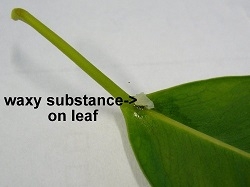Advice from the Master Gardeners of Contra Costa's Help Desk
The Client's Concerns and Requests:
"waxy" deposit on leaf
Response from the MGCC Help Desk:
Thanks for bringing the Ficus benjamina (Weeping Fig) leaf samples and photos into the MGCC office this morning. Having a sample made it easy to see the white sticky globs at the base of each leaf. When we looked at the leaf under the microscope, there were no insects present on the leaf or under the white waxy substance. We also looked at another Ficus growing in our office and found that it, too, had the same white sticky globules on the base of each leaf.
potted indoors
You also mentioned that you might also have a sticky substance in the middle of the lower surface of some of the leaves. If these are in locations where they wouldn't be a drip from the leaf gland of possibly a nearby leaf, it is possible that you might have scale or another sucking insect. As I mentioned, we didn't see anything under the microscope. You might want to examine your leaves, and contact us if you do see any signs of scale or other insect. (Although not a UC guidance document, the UC references cited in the article on Ficus Benjamina Pests” at http://homeguides.sfgate.com/ficus-benjamina-pests-40044.html would be the primary UC guidance MGCC would use to determine appropriate care if there were pests on your Ficus.)
Ficus are notoriously finicky about water, light, and transplanting. From the picture you provided, it looks like you have a nice light filled location for your tree. Because the back corner is dark, it is a good idea to frequently rotate the pot. You mentioned that some of the leaves are turning yellow. Yellowing leaves can be a sign that it is either getting too much or not enough water. (We did mention that Ficus are finicky?) You said that you water your plant once a month, just until runoff, and that the roots are “tight”. It may be that the root ball is very compacted and not able to take up enough water because the water is quickly running through the pot. One method of helping to get the root ball to take up water we would propose would be that several times a year when you water the plant, completely submerse the pot in a tub, bucket or pot of water. Leave it for several hours, giving the rootball a change to become fully saturated. You will want to drain off any free flowing water when you remove your plant from the tub/bucket/pot. After that continue watering as usual.
Regarding repotting, check the roots of your Ficus tree to determine if/when it is time to repot the Ficus. If the pot appears crowded with roots and there is little soil left, your Ficus has probably become root-bound and needs to be repotted. When repotting, after removing the tree from the pot, brush the soil away from the root ball to assess how badly root-bound the Ficus has become. If some of the roots have begun to circle around the ball, carefully unwind them with your fingers. Gently separate the roots in the root ball, releasing any dirt that may have been clogging it. Cut off any dead or rotten roots using a small pair of gardening scissors or pruning shears. If any of the roots have begun to grow through the drainage hole in the pot, prune these back as well. Select a new pot that is 1 or 2 inches wider in diameter than the old pot. Fill the bottom with several inches of fresh potting soil, place the tree into the pot, and backfill with new potting soil to cover the roots and stabilize the tree. Often when their environment is changed, whether a change in water, light, rotating the plant, or transplanting there is a chance the Ficus will drop its leaves - but in time they should grow back.
Feel free to contact us if you have any additional questions.
Happy gardening with a great indoor plant.
Master Gardeners of Contra Costa's Help Desk
Note: The Master Gardeners of Contra Costa's Help Desk is available year-round to answer your gardening questions. Except for a few holidays, we're open every week, Monday through Thursday for walk-ins from 9:00 am to Noon at 75 Santa Barbara Road, 2d Floor, Pleasant Hill, CA 94523. We can also be reached via telephone: (925) 646-6586, email: ccmg@ucanr.edu, or on the web at http://ccmg.ucanr.edu/Ask_Us/